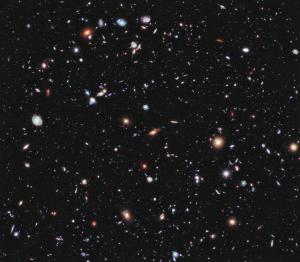Post
More Things in
Heaven and Earth
25 September 2012
 NASA; ESA; G. Illingworth, D. Magee, and P. Oesch, University of California, Santa Cruz; R. Bouwens, Leiden University; and the HUDF09 Team
NASA; ESA; G. Illingworth, D. Magee, and P. Oesch, University of California, Santa Cruz; R. Bouwens, Leiden University; and the HUDF09 TeamSuppose you picked up a grain of sand and held it at arm’s length. If you held it up in the night sky, it would block a tiny fraction of the visible heavens. Now suppose instead of of a sand grain it were a tiny window, through which you could see even the faintest light. Finally, suppose you were to take your tiny window and point it at the darkest patch of night you could find. What would you see?
Of course we have such a “window,” called the Hubble telescope, and we’ve done just what I’ve described several times. This time we aimed it at one of the darkest patches of sky we could find, in the Fornax constellation. After gathering light for a total of almost 23 days, what we got was the image below, just released today. It is known as the Extreme Deep Field.
Take a moment to let the profound nature of this image sink in. This image is what we got when we pointed the Hubble telescope at what looked like empty space. Each smudge of light in this image is a young galaxy, from about 500 million years after the big bang. Thousands of galaxies in a patch of sky the size of a grain of sand.
Of course there isn’t anything particularly special about the direction we looked other than the fact that there wasn’t anything in the way. If we looked in any other direction we would see basically the same thing. Imagine the sky covered with grains of sand, and in each sand grain thousands of galaxies. It’s estimated that there are 100 billion galaxies in the visible universe. That’s more than 10 galaxies for every man, woman and child on Earth. Those galaxies might have an average of about 100 billion stars. Around most of those stars might be tens of planets. Countless cosmic grains of sand.
More in heaven and earth indeed.